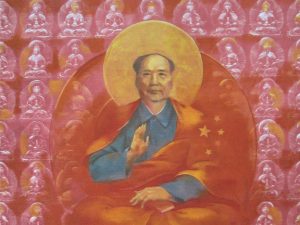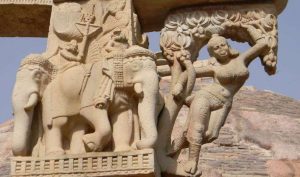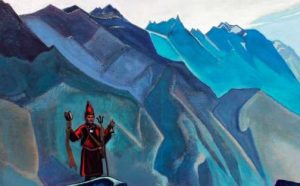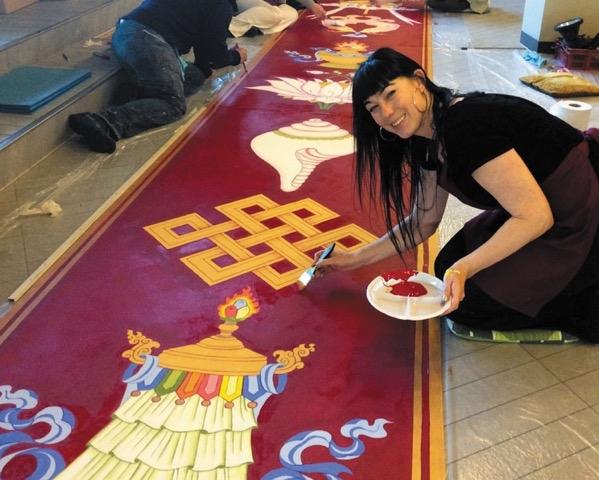
The origins and meanings of the Eight Auspicious Symbols
In my previous article,* I wrote about the large paintings that I was asked to create for the visits of His Holiness the Dalai Lama to the Netherlands in 2009 and 2014. Traditionally, highly respected lamas are welcomed with a representation of the Eight Auspicious Symbols—the best-known group of symbols in Tibetan Buddhism—in the form of a painting, or depicted using flour or colored powders. The images in this article are taken from the 30-foot painting I created with the help of my students for the Dalai Lama’s visit to the Netherlands last year.
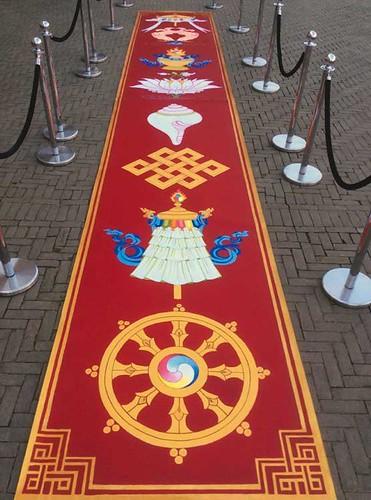
for His Holiness the Dalai Lama
Besides being decorative, the Eight Auspicious Symbols are considered signs of spiritual and material well-being. In this article I will explain more about the origin and meanings behind these symbols.
Called Ashtamangala in Sanskrit (ashta meaning “eight” and mangala meaning “auspicious”), the Eight Auspicious Symbols consist of the parasol, the pair of golden fish, the treasure vase, the white lotus, the conch shell, the endless knot, the victory banner, and the wheel of Dharma. The symbols can be traced back to the birth of Buddhism in ancient India, when they were closely associated with royalty and were displayed at ceremonies, such as the coronation of a king.
In Buddhism, these eight symbols of good fortune represent the offerings made by the Hindu deities to the historical Buddha, Shakyamuni, immediately after he attained enlightenment. Brahma, the great god of the form realm and creation, was the first to appear with an offering of a thousand-spoked golden wheel, requesting Shakyamuni to turn the wheel of the Dharma, which represents the Buddhist teachings. Next came the great sky god Indra, who presented a white, right-spiraling conch shell as a symbol of spreading the Dharma. In this way, the Hindu deities acknowledged that the Buddha’s achievement was far greater than theirs and that he had truly left the world of suffering behind.
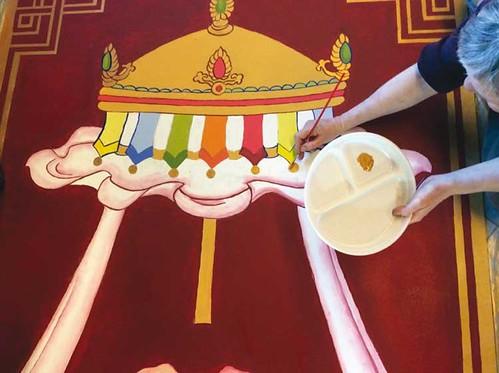
The parasol is a symbol of both protection and royalty (in ancient times, one had to be rich to possess such an item and also needed a bearer to carry it). It represents the protection from negative influences and hindrances that is offered to all who follow the path of the Dharma.
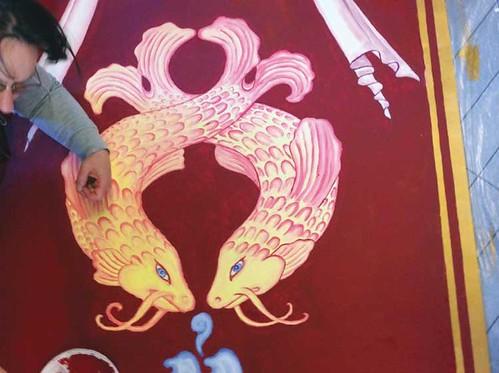
The pair of golden fish, one female, one male, represents spiritual release from suffering in samsara (the cycle of death and rebirth within the six realms that is caused by our karma). As fish are untroubled by turbulent waters when they swim through the deep oceans, they symbolize a state of fearlessness. The Dharma practitioner “swims” without drowning in the ocean of suffering, migrating from place to place freely and spontaneously, just as fish do. The fish are often depicted as carp, which are commonly regarded in Asia as sacred because of their beauty, size, and long lifespan.
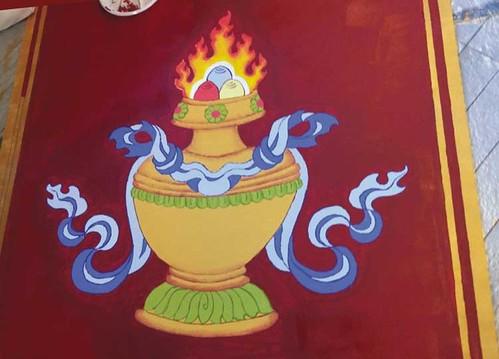
The treasure vase is golden in color and is modeled on the traditional Indian clay or metal water pot, which has a flat base, a round body, and a narrow neck. It pours forth long life, health, wealth, prosperity, and all the benefits of this world to those who sincerely follow the Dharma path.
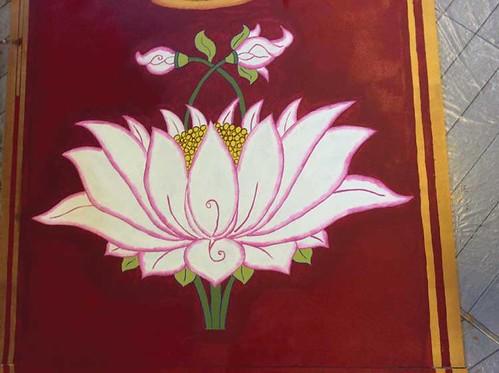
The white lotus symbolizes spiritual purity—the complete purification of body, speech, and mind. The symbol also represents key aspects of the Dharma as it grows from the mud (samsara), it appears clean on the surface (purification), and it finally produces a beautiful flower (enlightenment). The lotus throne on which most deities sit or stand symbolizes their natural purity. The deities manifest in cyclic existence, yet they are completely free from its defilements, emotional hindrances, and obscurations. Many, such as Green Tara, White Tara, and Avalokiteshvara (Chenrezig in Tibetan), are depicted holding one or two lotus flowers in their hands.
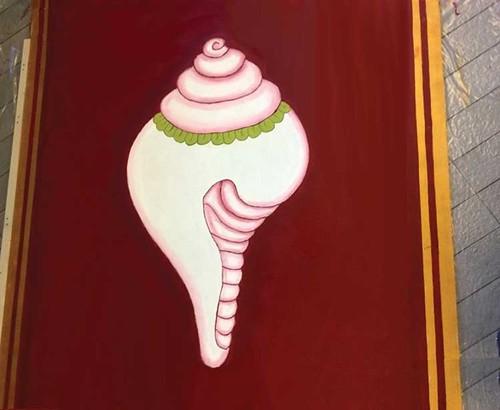
The conch shell is blown to signal the Buddha’s enlightenment to the world. It symbolizes the deep, far-reaching, and melodious sound of the Dharma teachings, which are suitable for all disciples as they awaken from the “sleep of ignorance.” When the conch shell is used as a ritual instrument in Tibetan Buddhist ceremonies, it is ornamented with a metal mouthpiece.

The endless knot has no beginning and no end, representing the beginningless cycle of rebirth. It indicates the union of wisdom and compassion, which together signify enlightenment.
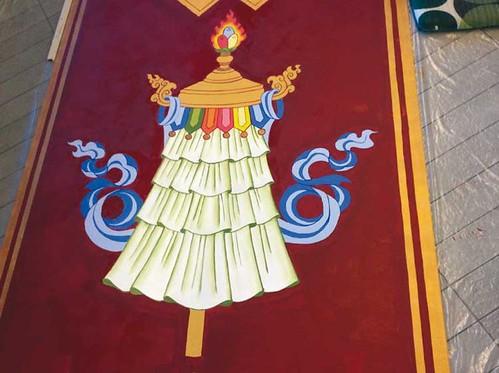
The victory banner stands on top of Mount Meru, regarded as the center of the universe in Indian cosmology and Tibetan Buddhism. It symbolizes the victory of the Dharma teachings over ignorance, disharmony, and all the negativities of this world. Cylindrical victory banners made of copper are traditionally placed at the four corners of the roof in Tibetan monasteries and temples.
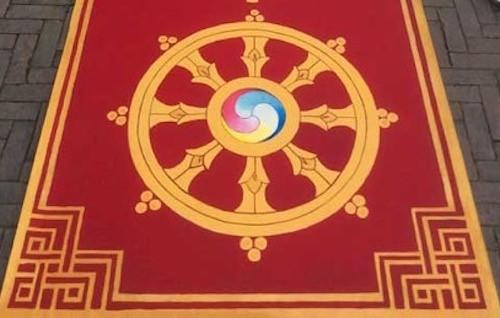
The wheel of Dharma has eight spokes representing the Noble Eightfold Path: right view, right thought, right speech, right action, right livelihood, right effort, right mindfulness, and right concentration. As the wheel of Dharma turns, it awakens the Buddha nature that exists within all sentient beings. The wheel also stands for motion, continuity, and change.
Artistically, these Eight Auspicious Symbols can be depicted individually, in pairs, in fours, or as a composite group of eight. When combined, they are often depicted intertwined, almost forming an entirely new symbol that is frequently painted on the inside walls of monastery courtyards.
The popularity of these symbols among Tibetan Buddhists has remained undiminished over the centuries. In addition to adorning monasteries, they can also be found in the homes of most Tibetan people, decorating all manner of sacred and not-so-sacred objects, such as wooden furniture, metalwork, carpets, and embroidered brocades.
In these turbulent and uncertain times, it is my hope that these symbols will remain an emblem of hope and benefit, and of the triumph of the positive over the negative.
Carmen Mensink is a member of the Dakini As Art Collective. She is an internationally renowned painter of thangkas. Based in Amsterdam, Carmen teaches this beautiful art, as well as Buddhist meditation and philosophy, at museums, universities, and Buddhist centers around the world. To learn more about Carmen, her work, and Dakini As Art, please visit Dakini As Art.
*Painting the Eight Auspicious Symbols for the Dalai Lama (Buddhistdoor Global)
See more




